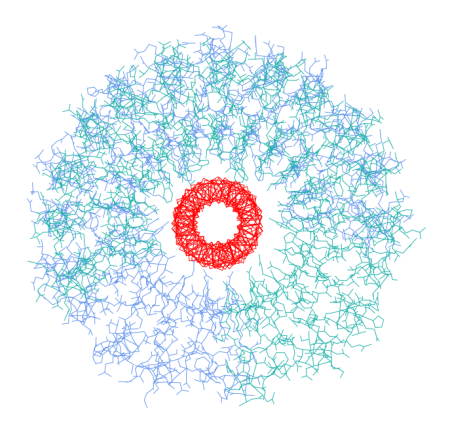
This post starts a series devoted to imaginary nanodevices made of proteins. I’m going to play around with known protein structures to see if some of them can form an interesting arrangement. Basic requirement is lack of obvious sterical clashes at the level of a main chain trace. If that is fulfilled I would assume very slight chance that particular arrangement is possible. However, in most cases I won’t bother inventing how to recreate it in the lab, since I don’t feel competent enough. The whole series is more fiction than science and my goal is mainly stretching my and readers imagination.
Lets start with something simple. Structure depicted above is a dimer of leucin rich repeat (LRR) protein (PDB: 1A4Y, chains A and D) with a trimeric coiled-coil (my own model made with BeammotifCC) fitted in. The opening is wide enough to accommodate three helices without any problems. Picture below shows main chain trace of the coiled-coil (in red) surrounded by LRR dimer (all atoms, blue and sea green). As you can see, any coiled-coil made of aminoacids with small side chains would not create any sterical issues. In fact, approximate size of the opening (~35 Angstroms) is much larger than the opening size of the membrane anchor of trimeric autotransporter adhesins (twelve stranded beta-barrel, PDB: 2GR7), which also accommodates a trimeric coiled-coil. So why not to use a beta-barrel instead of LRR? Well, beta-barrels are hardly present outside membranes 🙂 .

One can ask question if the single LRR protein can make a full ring. It looks possible from the structure of the single repeat (beta-turn-alpha) – interactions with preceding and following repeats are virtually the same. However, secondary structure elements of these repeats are not perfectly aligned with the axis of the opening. Their tilt forces consecutive repeats to form an imaginary spiral, not a circle (although the tilt does not seem to be large enough to actually allow for spiral folding of larger number of repeats – but that’s only my assumption, it would be worth to check).
So that’s it for now. If you feel that I’m rediscovering wheel, writing something completely silly, or you have any suggestions, please feel free to discourage/encourage me with comments.





